Non-Animal Alternative Testing Market Research, 2030
The global non-animal alternative testing market size was $9.8 billion in 2021, and is projected to reach $29.4 billion by 2030, growing at a CAGR of 13.5% from 2022 to 2030. Sales of non-animal alternative testing products and services, which do not utilize animals in testing to establish safety requirements for products such as pharmaceuticals and cosmetics, are included in the non-animal alternatives testing market. Drug and cosmetic items are tested using non-animal methods in the non-animal alternative testing industry. Some procedures and methodologies utilized as an alternative to animal testing include organs-on-chip, in-vitro testing, and in-silico testing.
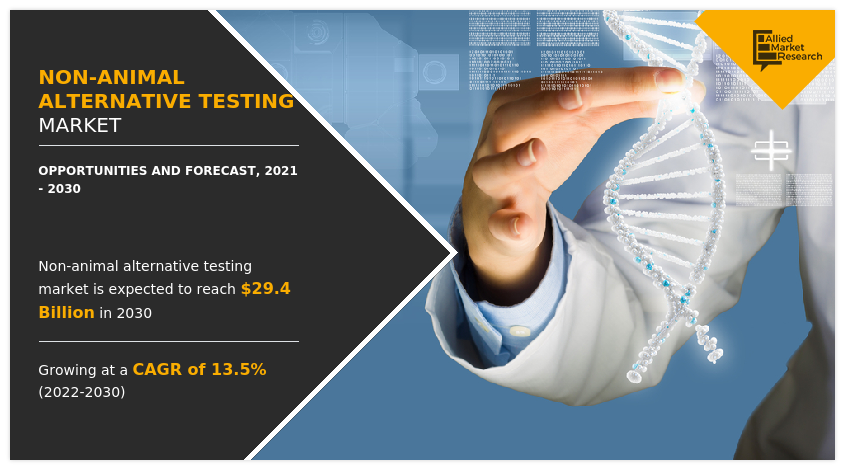
The market for non-animal testing is expanding due to support from the government and non-governmental organizations. In addition to enforcing rules and regulations, government organizations raise funds to support non-animal testing methods such as tests on human volunteers, advanced computer modelling tools, and funding for studies involving human volunteers. The market for non-animal testing is expanding due to the government's ongoing support. As an alternative to animal testing, companies in the non-animal testing sector are spending more on technologies such as organs-on -chip. Instead of employing an animal for the test, the organs-on-chip technology uses human cells on a chip to simulate the structure and operation of human organs and organ systems.
The approval of the sale of a number of products, including pesticides, industrial chemicals, pharmaceuticals, medical equipment, vaccines, genetically modified foods, and some consumer products, requires mandatory animal testing. Due to their legal systems, some nations still demand the use of animals in animal testing for any special purpose items, non-routine tests, and imported cosmetics. Thus, the expansion of the market will be hampered by the legal requirements in some countries for animal testing.
A major opportunity in the market for testing non-animal alternatives is the Organs-On-Chip (OOC) instrument. OOCs are tiny organs and tissues developed in a dish that allow researchers to simulate human physiology and illness. OOCs are currently being researched on a global scale as instruments for creating disease models and precisely forecasting the efficacies and toxicities of drugs. Both the medical and pharmaceutical communities, who are concentrating on developing targeted medicines, have become interested in OOCs due to their benefits over cell culture, animal models, and human clinical trials. Another significant development in the non-animal alternative testing business is the use of human-patient simulators for testing. These life-size adult and newborn patient simulators for human patients simulate certain aspects of human physiology. They have been demonstrated to be more successful than crude exercises that involve brutally torturing animals for teaching students about physiology and pharmacology.
The key players profiled in this report include VITROCELL Systems GmbH, Evotec SE, Biovit, MB Research Laboratories, Emulate, Inc., TARA Biosystems, Inc., Bio-Rad Laboratories, Inc., Abbott, Hurel Corporation, and TissUse GmbH.
The global non-animal alternative testing market is segmented on the basis of technology, method, end-user, and region. By technology, the market is sub-segmented into cell culture technology, high throughput technology, molecular imaging, and omic technology. By method, the market is sub-segmented into cellular assay, biochemical assay, in silico, and ex-vivo. By end-user, the market is classified into pharmaceutical industry, cosmetics & household products, diagnostics, chemical industry, and food industry. By region, the market is analyzed across North America, Europe, Asia-Pacific, and LAMEA
The non-animal alternative testing market is segmented into Technology, Method and End User.
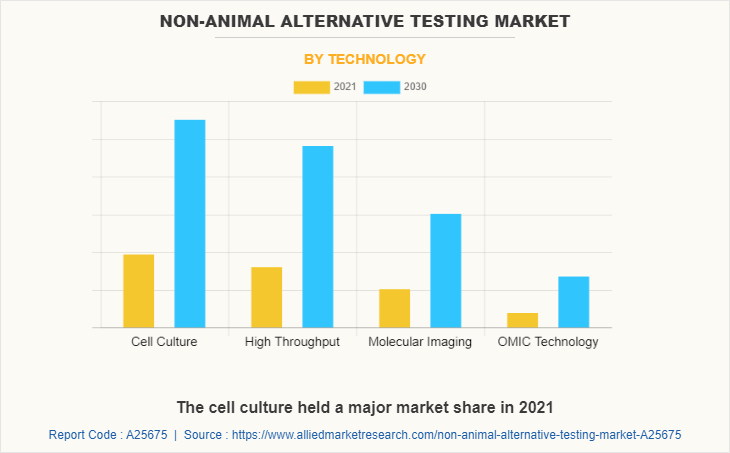
By technology, the cell culture technology sub-segment dominated the market in 2020, whereas the omic technology sub-segment is projected to be the fastest growing during the forecast period. The expansion of the sub-segment is caused by the researchers' extensive use of cell culture equipment to examine many test findings at once. With this approach, numerous pharmacological tests are carried out on eukaryotic cells, preferably human cells that have been cultivated under carefully controlled in vitro conditions to replicate the environment of the human body. Such factors are probably going to drive the market expansion in the future.
The ability of omic technology to analyze human cell and drug interactions in detail as well as aid in comprehending the genetic make-up of diseased cells is fuelling the sub-segment growth. With this knowledge, scientists may readily create drugs that target the defective gene in a diseased cell. These factors are expected to produce enormous market revenues.
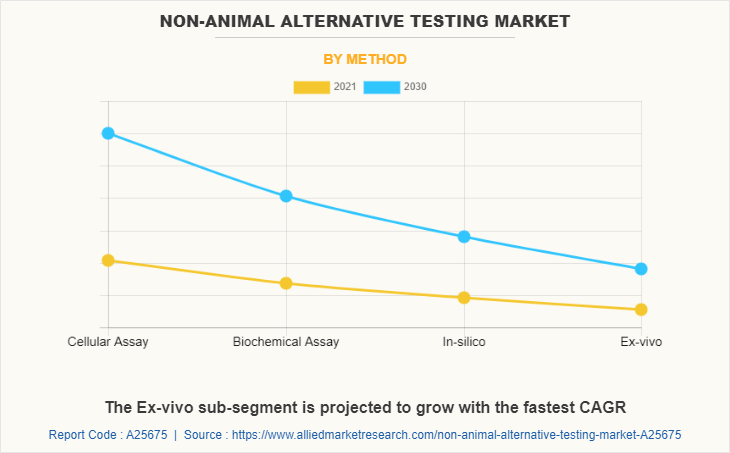
By method, the sub-segment cellular assay dominated the market in 2020, whereas the ex-vivo sub-segment is projected to be the fastest growing during the forecast period. The sub-segment is anticipated to increase significantly over the coming years as a result of rising interest in researching and evaluating a significant volume of human cellular data during pre-clinical trials. Thus, it is bound to create a scope of growth for the sub-segment during the forecast period.
The rapidly growing need for artificial organs in the cosmetic business to evaluate the sensitivity of cosmetic goods is responsible for the increase in the revenue of the ex-vivo sub-segment. In order to replicate the human environment and serve as a model for product testing, numerous human organs are created in vitro. The cosmetic business may lessen the usage of animal models and avoid any ethical problems in this way. These factors are predicted to drive the market expansion in the future.
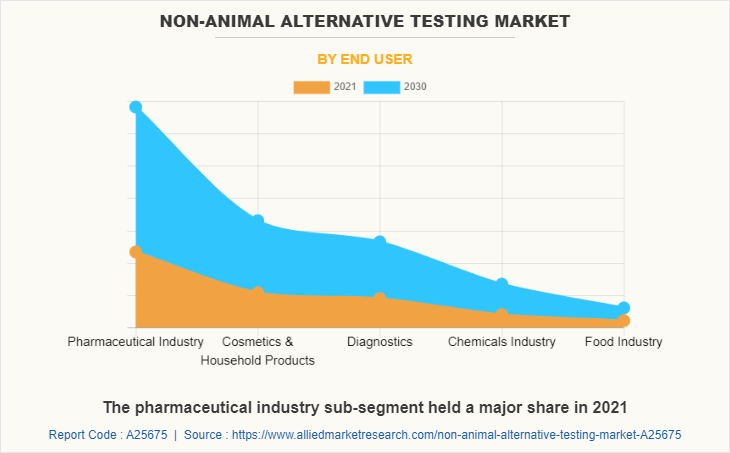
By end-user, the pharmaceutical sub-segment dominated the global non-animal alternative testing market share in 2020, whereas the chemical industry sub-segment is anticipated to have the fastest growth during the forecast period. The pharmaceutical industry's growing research and development efforts to provide new medications for a variety of disorders are driving the sub-segment growth. Additionally, the increasing objection to using animals for drug testing has motivated businesses to employ in silico drug testing procedures in order to avoid any potential ethical dilemmas. Such factors are anticipated to fuel the market expansion in the future. The increase in the usage of various chemicals in the production of goods for human consumption is responsible for growth of the chemical industry sub-segment. Prior to being suitable for human use, chemicals must first undergo sensitivity and effectiveness testing. These factors are projected to boost the market revenue during the forecast time frame.
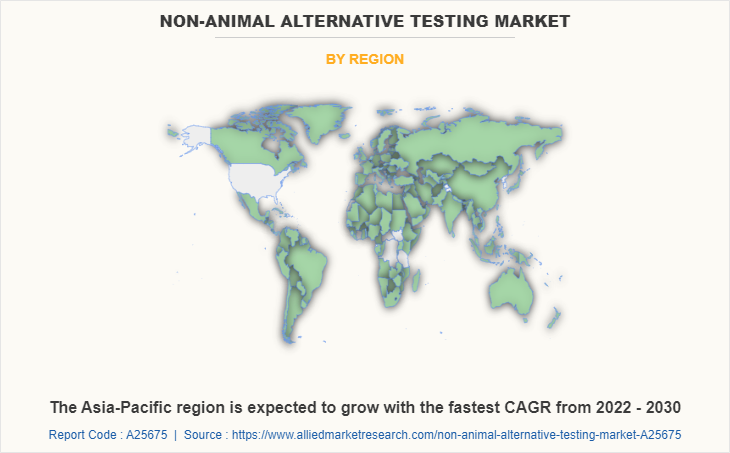
By region, the North America dominated the global market in 2020, whereas the Asia-Pacific region is anticipated to have the fastest growth during the forecast period. Major non-animal alternative testing companies such as Abbott Laboratories are present in the North American region, which is considered to be a major contributor to the expansion. The market for non-animal alternative testing is also anticipated to develop in the coming years due to the ageing population and the incidence of chronic diseases among North American population.
Whereas, Asia-Pacific market is anticipated to rise as a result of the growing moral concerns about animal suffering, the region is subject to a rising ban on using animals in pre-clinical testing. In addition, leading market players are now investing in the introduction of new products in the region in order to support the development of research facilities and activities. In the coming years, these factors are projected to fuel the market expansion for non-animal alternative testing.
Highlights of the Report
- The report provides exclusive and comprehensive analysis of the global non-animal alternative testing market trends along with the non-animal alternative testing market forecast
- The report elucidates the non-animal alternative testing market opportunity along with key drivers, and restraints of the market. It is a compilation of detailed information, inputs from industry participants and industry experts across the value chain, and quantitative and qualitative assessment by industry analysts
- Porter’s five forces analysis helps analyze the potential of the buyers & suppliers and the competitive scenario of the market for strategy building
- The report entailing the non-animal alternative testing market analysis maps the qualitative sway of various industry factors on market segments as well as geographies
- The data in this report aims on market dynamics, trends, and developments affecting the non-animal alternative testing market growth
Impact of COVID-19 on the Global Non-Animal Alternative Testing Industry
- The global non-animal alternative testing industry is expected to expand in forecast period as a result of the COVID-19 pandemic
- The pharmaceutical industry has seen a considerable increase in demand for medications during the pandemic period as people's awareness regarding their health and wellbeing increased
- Additionally, during pre-clinical drug testing, several drug developers avoided working in wet laboratories and coming into direct touch with humans or animals.
- As a result, there is a significant increase in demand for non-animal alternative testing, which is boosting the market growth for non-animal alternative testing during the pandemic.
Non-Animal Alternative Testing Market Report Highlights
| Aspects | Details |
| Market Size By 2030 | USD 29.4 billion |
| Growth Rate | CAGR of 13.5% |
| Forecast period | 2021 - 2030 |
| Report Pages | 180 |
| By End User |
|
| By Technology |
|
| By Method |
|
| By Region |
|
| Key Market Players | Biovit, Bio-Rad Laboratories, Inc., TissUse GmbH, Hurel Corporation, VITROCELL Systems GmbH, Evotec SE, TARA Biosystems, Inc., Emulate, Inc., Abbott, MB Research Laboratories |
Analyst Review
There are rising cases of chronic diseases such as high blood pressure, diabetes and also increase in the number of viral diseases among millennial as a result of factors such as bad food eating habits. Several times, the virus develops a particular medicine resistance, making it impossible to treat the patient's illness with any medication. This has significantly raised the market demand for new medications. Future market growth for non-animal alternative testing is projected to be boosted by this factor during the forecast period. In addition, the market for non-animal testing is expanding due to the government's ongoing support, which is expected to fuel revenue growth of the market in the forecast timeframe. However, lack of awareness related to non-animal alternative testing methods among the scientists is expected to hamper the market revenue growth during the forecast period. Moreover, Organs-On-Chip (OOC) and human patient simulators are anticipated to provide remunerative opportunities for key players to maintain the pace of the non-animal alternative testing market in the upcoming years.
Among the analyzed regions, North America is expected to account for the highest revenue in the market. The market for non-animal alternative testing is also anticipated to develop in the coming years due to the ageing population and incidence of chronic diseases among North American population.
The diverse applications of non-animal alternative testing across chemical testing, medicine development, cosmetic product testing, and other sectors is the major market driver.
The major growth strategies adopted by non-animal alternative testing market players are investment and merger & acquisitions.
Asia-Pacific will provide more business opportunities for the global non-animal alternative testing market in future.
VITROCELL Systems GmbH, Evotec SE, Biovit, MB Research Laboratories, Emulate, Inc., TARA Biosystems, Inc., Bio-Rad Laboratories, Inc., Abbott, Hurel Corporation, and TissUse GmbH are the major players in the non-animal alternative testing market.
The pharmaceutical industry sub-segment acquired the maximum share of the global non-animal alternative testing market in 2020.
Pharmaceutical industries are the major customers in the global non-animal alternative testing market.
The report provides an extensive qualitative and quantitative analysis of the current trends and future estimations of the global non-animal alternative testing market from 2021 to 2030 to determine the prevailing opportunities.
The use of non-animal alternative testing in developing drug testing solutions for various ailments such as diabetes and using non-animal preclinical testing for pharmaceuticals and cosmetics is estimated to drive the adoption of non-animal alternative testing.
Increasing application of non-animal alternative testing in the production of pharmaceuticals and cosmetic products is anticipated to boost the non-animal alternative testing market in the upcoming years.
Loading Table Of Content...
Loading Research Methodology...



